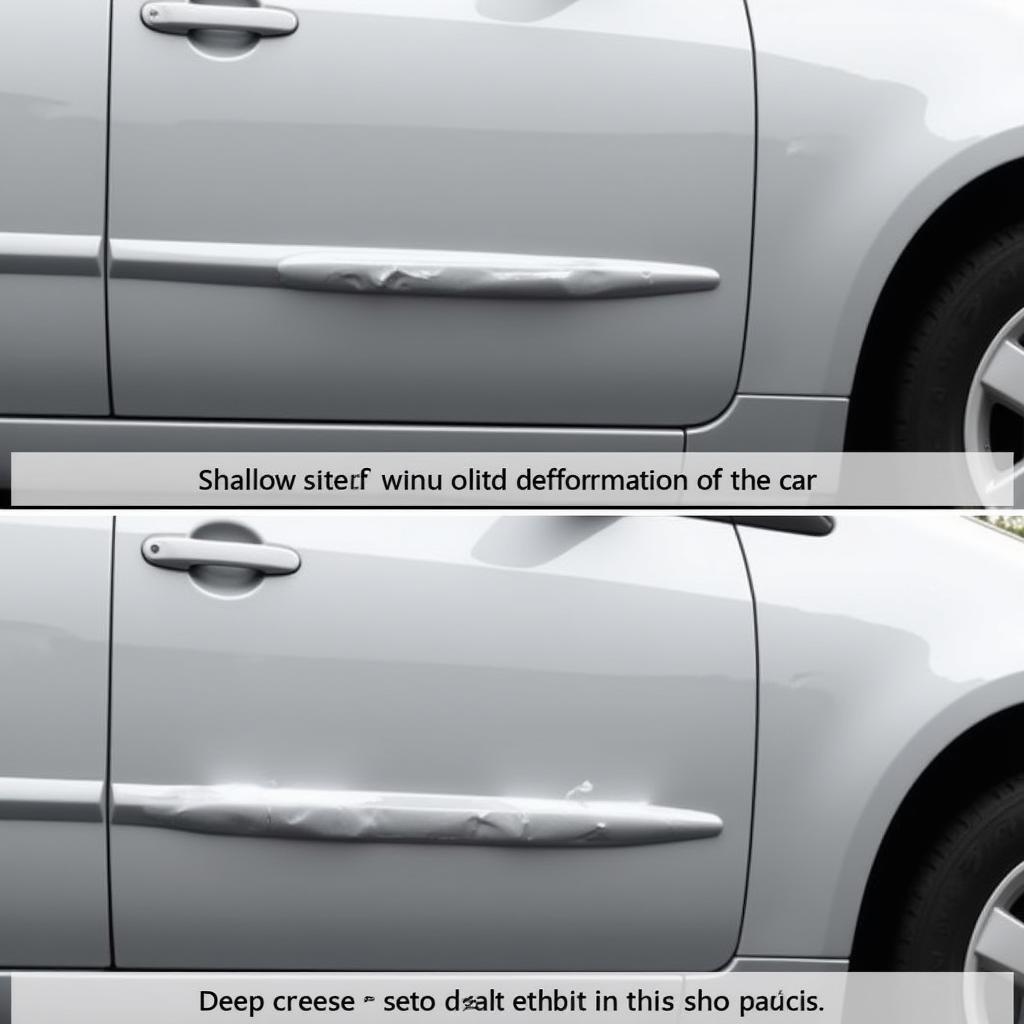Fixing Car Dents Yourself can be a cost-effective way to restore your car’s appearance. While some dents require professional attention, minor dents and dings can often be addressed at home with the right tools and techniques. This guide will provide a comprehensive overview of DIY dent repair, from assessing the damage to achieving a professional-looking finish.
Understanding the Dent: Types and Severity
Before you begin fixing car dents yourself, it’s crucial to assess the damage. Dents vary in size, depth, and location, and each requires a slightly different approach. A small, shallow dent on a flat panel is generally easier to fix than a deep crease on a curved surface. Knowing the type of dent you’re dealing with will help you choose the right method and tools.
Shallow Dents vs. Deep Creases
Shallow dents often respond well to paintless dent repair (PDR) techniques, which involve manipulating the metal back to its original shape without affecting the paint. Deep creases, however, may require filling and sanding before repainting. Understanding this distinction is essential for successful dent repair.
 Shallow Dent vs. Deep Crease in Car Door
Shallow Dent vs. Deep Crease in Car Door
Tools and Materials for DIY Dent Repair
Fixing car dents yourself requires a few specialized tools. These range from simple household items to more specialized dent removal kits. Gather the necessary materials before you begin to ensure a smooth and efficient repair process. Some common tools include suction cup dent pullers, glue tabs, and dent repair kits with various tools and accessories.
Essential Tools for Dent Removal
- Suction Cup Dent Pullers: These tools use suction to pull out shallow dents. They’re effective for small dings and can be a quick fix for minor damage.
- Glue Tabs and a Slide Hammer: Glue tabs are attached to the dent, and a slide hammer is used to pull the dent out. This method provides more controlled pulling force than suction cups.
- Dent Repair Kits: These comprehensive kits usually include a variety of tools, such as glue tabs, pullers, and knock-down tools, offering versatility for different types of dents.
- Heat Gun or Hair Dryer: Applying heat to the dented area can sometimes help the metal become more pliable, making it easier to reshape.
Step-by-Step Guide to Fixing Car Dents
Now, let’s dive into the process of fixing car dents yourself. Follow these steps carefully to achieve the best results. Remember, patience and precision are key to a successful DIY dent repair.
- Clean the Area: Thoroughly clean the dented area with soap and water to remove any dirt or debris. This will ensure proper adhesion for glue tabs or suction cups.
- Assess the Dent: Determine the type and severity of the dent to choose the appropriate repair method.
- Apply Heat (If Necessary): For deeper dents, apply heat to the area using a heat gun or hair dryer. This can make the metal more malleable.
- Use a Dent Puller or Glue Tabs: Apply a suction cup dent puller or attach glue tabs and use a slide hammer to pull the dent outward. Similar to how to fix a car hood, this process requires gentle, controlled force.
- Knock Down High Spots: Use a knock-down tool to gently tap down any remaining high spots or imperfections.
- Inspect and Repeat: Inspect the repaired area and repeat the process if necessary until the dent is sufficiently removed.
 Step-by-Step Car Dent Repair Process
Step-by-Step Car Dent Repair Process
When to Call a Professional
While fixing car dents yourself can be a rewarding experience, some dents require professional expertise. Deep dents, dents on complex curves, or dents with significant paint damage are best left to experienced technicians. If you’re unsure about your ability to fix a particular dent, it’s always best to consult a professional. This is especially true for complex repairs like how to fix a deep intention in my car or how to fix a shot car body. For issues with your car’s glass, knowing how to fix a car window can be helpful. However, if the damage is extensive, professional help might be necessary.
Thinking about how much to fix chip paint on car after a minor incident? Minor paint chips can often be addressed with DIY solutions, but larger areas or those impacting deeper layers may require professional attention.
Conclusion
Fixing car dents yourself can be a satisfying and cost-effective way to maintain your car’s appearance. By following the steps outlined in this guide and using the right tools, you can successfully repair minor dents and dings. However, remember to assess the damage carefully and don’t hesitate to seek professional help when needed. For more specific repairs, check out our guides on how to fix a car hood. Contact AutoTipPro at +1 (641) 206-8880 or visit our office at 500 N St Mary’s St, San Antonio, TX 78205, United States, for professional assistance.






Leave a Reply